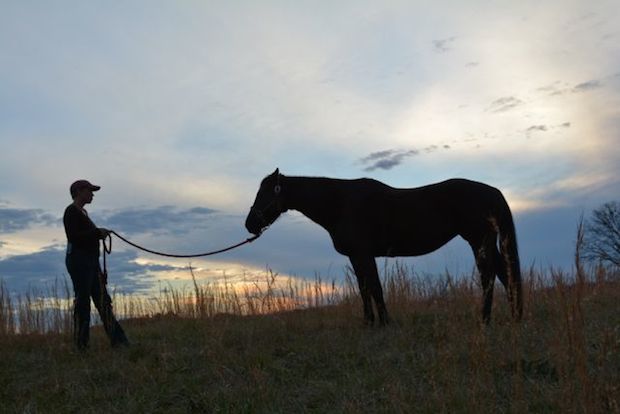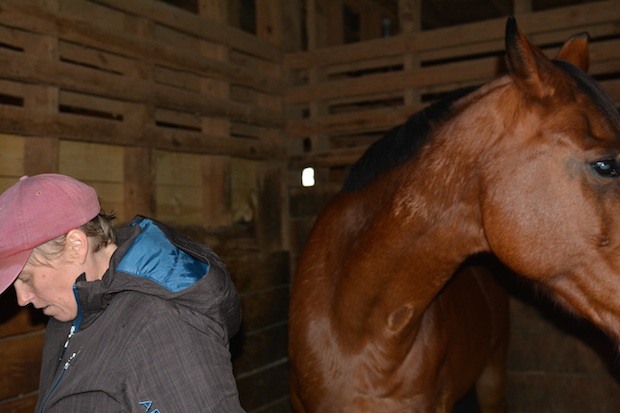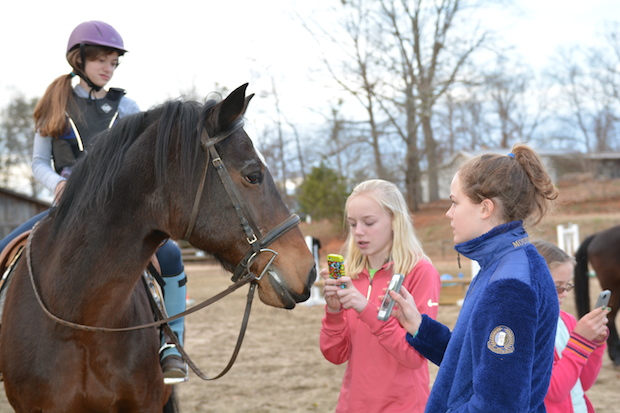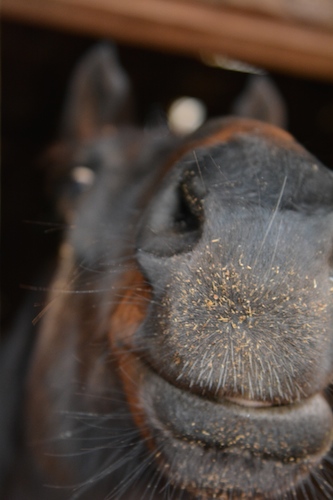Today, for the first time in my life as a riding instructor, I asked my students to consider what should be the most fundamental question: What does your horse need right now?
Because we know what we need. We need them to trot. We need them to canter. We need them to go over that jump — no, I’m serious, go over that jump right now…wait, back her up, control her shoulders, I’m serious, get that mare over that jump. Right now.
What does your horse need?
To answer that question, we have to find a point of stillness. In the words of Lao Tzu, “To the mind that is still, the whole universe surrenders.”

My co-trainer, Sarah Boudreaux, has been through a lot this past year. We prefer to think of the year as fiscal rather than calendar at the barn, which gives us the freedom to say things like: “I know this year will be better than last year — but it begins on February 1st.” Sarah had some broken ribs and a concussion from a fall in 2014, and she started the New Year off right with a car accident that required the reconstruction of her knee. That’s a lot of time out of the saddle, and Sarah is the sort of rider who takes her riding time seriously. She arrives at the farm early in the mornings to get a ride in before training starts in earnest and she’ll pencil a lesson in for herself weeks in advance. Sarah doesn’t cope well with downtime.
But, let’s face it. Horses like down time. A lot.

As the manager of the farm, I’m the co-pilot in Sarah’s misery, minus the aching pain and anesthesia and memory lapses (though it was great fun convincing her my name was Michelle on the drive to the urgent care center after that fall, and we like to blame all scheduling problems on Sarah’s pain pills — and will do so well after she recovers). Her journey is my journey because we’ve elected to do this horse thing together.
Sarah and I have spent a lot of hours over the years dissecting the trot, puzzling over hips and footfalls, perfecting canter departures and measuring bits. I can honestly say that no piece of equipment has changed our lives, whether adding or subtracting a piece of metal or leather, securing a spur or removing a noseband. We’ll keep doing all those things as long as we have horses in our lives.
But let me tell you about the moment that changed the way we ride and train from the core, from that secret place that all horse people store their passion. For me, that place rests right behind my solar plexus.
It felt good to sit and shut up for a change.
Sarah and I were stumped. We’d reached a training impasse with her big, draft mare Matilda, who in the manner of all big, draft mares, enjoyed throwing her shoulder and barging wherever she wished. I always like to blame things on heat cycles (people roll their eyes when I use this excuse on the geldings) because hormones are secret and mysterious and invisible and they’re good for blaming a whole lot of behaviors on.
We took the saddle and bridle off and allowed Matilda to roam free in the big jumping ring. Sarah and I stood in the center as Matilda milled around and ate grass along the edges and explored the poles and standards. It was a beautiful, sunny day, all warm sand and blue skies. We discussed heat cycles. Maybe a stronger bit?
We watched the use that Matilda made of the ring, given the choice to do whatever she wished. She used it like a turn-out paddock, doing what horses were designed to do: wandering, nibbling, snoozing.
Sarah and I sat down in the dirt and closed our eyes. Being a human with all our wondering and speculating and busy-ness is hard work. It felt good to sit and shut up for a change. It wasn’t planned. It just happened because the day was warm and a milling horse is a comforting sound for people who like the sort of thing.
How can we create a training environment where the horse can have a say in the partnership?
Maitlda is fifteen hundred pounds of pure love, but I tensed as she walked over to me and shifted around on her giant feet beside where Sarah and I sat. Matilda sniffed my hair and snuffled my shirt. She did the same to Sarah. And then she just stood with us, the big arc of her neck covering us in safety. We hung out in the arena for a very long time.
Matilda chose to be with us. Call that join up, bonding, clicking…whatever suits your discipline. In the words of Jayne Stewart, the big mare said “I see you.” And for once, Sarah and I said, “We see you back.”
Matilda didn’t join us as a result of force. She came to us because she made a choice. How can we create a training environment where the horse can have a say in the partnership? By asking this question, I’m not advocating the absence of training or the dissolution of disciplines. I’m saying that maybe, just maybe, we should spend a little time exploring the world from their point of view before we ask them to step up a level or raise the jump.
That moment took the resentment out of my work. Whenever one of the staff called in sick, I started taking the time to enjoy filling buckets as the horses explored me with wet lips. I felt their joy at feeding time. Eat, drink, wander, togetherness. That’s what they are about.
But we all have to work. In order for me to share my life with horses and for the horses to share their lives with me, we have to be in this thing together. We can’t create a utopia where the wild horses roam free on the plains. Our world is too small for this and we humans tend to forget that every member of the herd has a purpose.

Matilda’s training shifted after that moment in the ring. Her shoulders were still unruly, but the way she moved into the shedding blade for a scratch changed the tone of her lateral work. The steps back she took when asked to make room for a feed bucket developed into a backing under saddle. Knowing where her hind legs were improved the quality of her halt. Awareness. A dance. We finally figured out where ground work and riding merged. I wish I could find words to describe where that joining place is, but it’s as mysterious as hormones. It just is. And just when we’ve put our fingers on it, the connection recedes. So we have to keep looking for it, over and over, every time we step in the stirrup.
Sometimes life forces us to be still, as Sarah learned through recovery after injuries this year. Some of our best ideas were spawned in her convalescence. It’s a balance: work, stillness, pressure, release.
One of my favorite exercise for riders of all ages is to lead them around the arena as they sit in the saddle and close their eyes. What are they feeling? What is happening underneath them? What are they experiencing? Our minds become still when we’re forced to listen. I’ve never led someone around on a glorified, blindfolded pony ride that didn’t end in a deep breath and smile from all parties. You know that cool down breath your horse gives you? That one.
Sometimes we, riders and instructors alike, need to just shut up and listen.

Originally published at BramblewoodStables.com
About the Author
Kim Carter is the owner and head trainer at Bramblewood Stables in Upstate South Carolina. A writer by trade and passion, she utilizes a multi-disciplinary approach to guide her students toward a greater connection to their horse and the world around them.


 May 27, 2016
May 27, 2016 
























